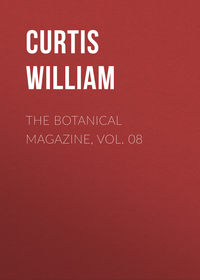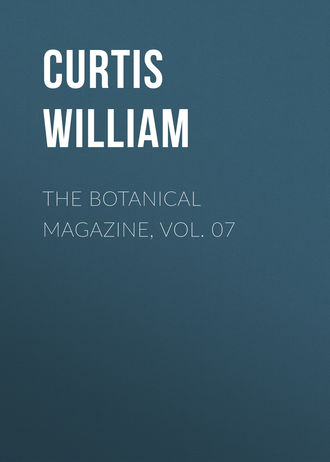 полная версия
полная версияThe Botanical Magazine, Vol. 07
PRIMULA acaulis foliis rugosis dentatis, subtus hirsutis; scapis unifloris. Jacq. Misc. Austr. p. 158. Curt. Flor. Lond. Fasc. 6.

No229.
The Primrose in its wild single state is frequently introduced into shrubberies and plantations, for the purpose of enlivening them in the spring months; in its double state it has been deemed peculiarly worthy of cultivation by the curious in flowers. Of the double yellow Primrose, which seems to have been the first known, we meet with a figure in the Hort. Eyst. and in the Parad. Terrestr. of Parkinson, since those publications many new and perfectly double varieties have been introduced, as
The double white, rarely met with.
The double deep red or velvet, the blossoms of this will sometimes come single.
The double pink or lilac, here figured, a plant much admired.
The double crimson, a new variety, which, in brilliancy of colour, far surpasses all the others.
The red, commonly called the Scotch Primrose, less ornamental than any of the preceding: besides these, we have observed a variety with blossoms of a dingy yellow inclining to red, not worth cultivating.
These several varieties of Primrose are admirably adapted to the decoration of the shrubbery, plantations, or even the north side of rock-work; they delight to grow in a stiff loam, a moist and somewhat shady situation, so planted they thrive admirably, the double succeeding almost as well as the single; every second or third year their roots should be divided, which may be done either in spring or autumn, they may be cultivated also in pots for the convenience of removing them when in blossom.
[230]
Plumbago Rosea. Rose-Coloured Leadwort
Class and OrderPentandria MonogyniaGeneric CharacterCorolla infundibuliformis: Stamina squamis basin corollæ claudentibus inserta. Stigma 5-fidum. Sem. 1. oblongum tunicatum.
Specific Character and SynonymsPLUMBAGO rosea foliis petiolatis ovatis glabris, subdenticulatis caule geniculis gibbosis. Linn. Syst. Vegetab. ed. 14. Murr. p. 199. Sp. Pl. ed. 3. p. 215. Ait. Kew. v. 1. p. 205.
PLUMBAGO zeylanica, folio splendento ocymastri, flore rubro. Burm. Zeyl. 195.
RADIX vesicatoria. Rumph. Amboin. 5. p. 453. t. 168.

No230.
The Plumbago rosea, one of the most ornamental plants which we keep in our stoves, is a native of India, from whence it was introduced to this country by the late Dr. Fothergill, in the year 1777, posterior to the publication of the last edition of Mr. Miller's Dictionary.
It is a shrubby plant, which frequently grows to the height of four or five feet, and is perpetually putting forth flowering spikes; these continue a long while in blossom, and hence, with proper management, it may be had to flower during most of the year, a very desirable circumstance in a plant of such singular beauty.
The usual mode of increasing it is by cuttings, which strike freely.
Its parts of fructification, whether we regard their colour or structure, are highly deserving of notice.
[231]
Fumaria Solida. Solid-Rooted Fumitory
Class and OrderDiadelphia PentandriaGeneric CharacterCal. diphyllus. Cor. ringens. Filam. 2 membranacea, singula Antheris 3.
Specific Character and SynonymsFUMARIA solida, caule simplici, bracteis brevioribus multifidis, radice solida. Mill. Dict. ed. 6. 4to.
FUMARIA bulbosa, caule simplici, bracteis longitudine florum. Linn. Syst. Vegetab. ed. 14. Murr. p. 636. Sp. Pl. ed. 3. p. 983. Ait. Kew. v. 3. p. 1.
FUMARIA bulbosa radice non cava major. Bauh. Pin. p. 144. Small hollow roote. Park Parad. p. 275. 279. f. 2.

No231.
By the old Botanists this species of Fumaria, whose root is constantly solid, was considered as a distinct species from another similar to it of larger growth, whose root is as constantly hollow, and which will be figured in the next number of this work; Caspar Bauhine in particular, in his Pinax, describes the characters in which they differ: Linnæus nevertheless makes them varieties of each other, uniting them under the name of bulbosa; from this union we have taken the liberty to dissent, choosing rather to follow Miller, who regards them as distinct, and the Botanists preceding him.
The Fumaria solida, a very old inhabitant of our gardens, is a plant of very humble growth, rarely exceeding three or four inches in height, and producing its spike of purple flowers in April, which continue in blossom about a fortnight.
In point of colour the flowers of this plant are not subject to much variation, we possess a variety of it with blossoms of a much brighter colour than those of the common sort, and which, on that account, is much more worthy of cultivation.
As a spring plant, it deserves a place in the garden; in point of ornament, it is applicable to the same purposes as the Primrose, will grow in almost any soil or situation, requires to be taken up in the autumn, and fresh-planted every two or three years; if suffered to remain in the same spot for a great length of time, it becomes smaller, produces few or no flowers, and is so altered in its appearance, as to look like another species.
[232]
Fumaria Cava. Hollow-Rooted Fumitory
Class and OrderDiadelphia HexandriaGeneric CharacterCal. diphyllus. Cor. ringens. Filamenta 2 membranacea singula Antheris 3.
Specific Character and SynonymsFUMARIA cava, caule simplici, bracteis longitudine florum integris, radice cava.
FUMARIA bulbosa radice cava major. Bauh. Pin. p. 143.
RADIX cava major. Park. Parad. p. 275.
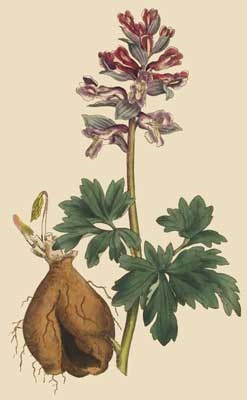
No232.
The hollow-rooted Fumitory differs from the solida, already figured, and that constantly, in a variety of particulars; its root is always, as far as we have observed, hollow, appearing sometimes, as Parkinson informs us, "like a shell, every part of which when broken will grow;" frequently acquiring a very great size; the plant itself usually grows to twice the height of the solida, bearing foliage and flowers proportionably large; its bracteæ or floral leaves, which in the solida assume a kind of finger'd appearance from the manner in which they are divided, in this are entire or but slightly indented; it flowers also about three weeks earlier.
Of the Fumaria cava there are three principal varieties in point of colour, viz. the white, the blush-coloured, and the purple, which, though plentiful in our gardens formerly, are now rarely met with; Mr. Chappelow informs me, that he found them all this spring, in an old plantation at Teddington, where they produced the most pleasing effect.
It begins to flower in March and continues in bloom three weeks or a month, rarely produces any seed, so that it is to be propagated only by dividing its roots; it is a hardy herbaceous plant, a native of Germany, and will grow in almost any soil provided it be planted in a shady situation.
[233]
Chironia Baccifera. Berry-Bearing Chironia
Class and OrderPentandria MonogyniaGeneric CharacterCor. rotata. Pistillum declinatum. Stamina tubo corollæ infidentia. Antheræ demum spirales. Peric. 2-loculare.
Specific Character and SynonymsCHIRONIA baccifera frutescens baccifera. Linn. Syst. Veget. ed. 14. Murr. p. 229. Ait. Kew. v. 1. p. 258.
CENTAURIUM minus arborescens pulpiferum. Comm. rar. 9. t. 9.
CENTAURIUM minus africanum arborescens angustifolium. Old. afr. 26.
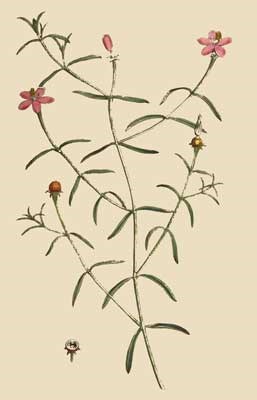
No233.
The Chironia baccifera, a native of Africa, is a plant not unfrequent in our greenhouses; its flowers are curious in their structure, of a lively hue, and suceeded by round seed-vessels, which, when ripe, have the appearance of red berries, whence its name of baccata; if we carefully examine these seed-vessels, we shall find that they are not properly berries, for on cutting them transversly, they are found to be hollow and to be divided into two cells (vid. Pl.) in which are contained small black seeds, whose surface is beautifully reticulated with impressed dots; the sides of the seed-vessel are fleshy, and do not appear to divide or split in any regular manner for the discharge of the seed; they must however be regarded rather as capsules than berries: in the genus Hypericum, the seed-vessels are found to vary in a somewhat similar manner; in this part of the fructification there is not, therefore, that deviation which has been supposed, but there is a very great one in the antheræ, which do not ultimately become spiral.
This plant, which grows to the height of a foot and a half or two feet, becomes very bushy, rather too much so in point of ornament, and produces both flowers, and fruit, during most of the summer.
Though regarded as a greenhouse plant, it does not ripen its seeds well unless kept in the stove; is with difficulty raised from cuttings, from seeds readily, by which it requires to be frequently renovated.
Was cultivated by Mr. Miller in 1759. Ait. Kew.
[234]
Linum Arboreum. Tree Flax
Class and OrderPentandria PentagyniaGeneric CharacterCal. 5-phyllus. Petala 5. Caps. 5-valvis, 10-locularis. Sem. solitaria.
Specific Character and SynonymsLINUM arboreum foliis cuneiformibus, caulibus arborescentibus. Linn. Syst. Vegetab. ed. 14. Murr. p. 303. Ait. Kew. v. 1. p. 388.
LINUM arboreum. Alp. Exot. 19. t. 13.
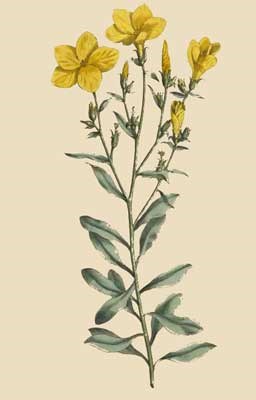
No234.
Contrary to what we observe in most of the plants of this genus, the present very rare and no less beautiful species of Flax forms (if not a tree, as its name imports) a shrub of the height of several feet, which begins to flower in the green-house in March, and continues to be more or less covered with blossoms to the close of the summer.
It is a native of the Levant, from whence it was introduced to this country in the year 1788, with a profusion of other vegetables, by John Sibthorp, M. D. the present celebrated Professor of Botany in the University of Oxford; who, for the laudable purpose of promoting the science in which he is so eminent, and of enriching the Oxford collection, already rendered most respectable by his unwearied labours, meditates, as we are informed, a second journey into Greece.
Hitherto this plant has produced no seeds in this country, and it is with difficulty increased by cuttings.
Our figure was drawn from a plant which flowered in the spring with Messrs. Grimwood and Co. Kensington.
[235]
Trollius Asiaticus. Asiatic Globe-Flower
Class and OrderPolyandria PolygyniaGeneric CharacterCal. 0. Petala circiter 14. Capsulæ plurimæ, ovatæ, polyspermæ.
Specific Character and SynonymsTROLLIUS asiaticus corolla patula, nectariis staminibus longioribus. Linn. Syst. Vegetab. ed. 14. Murr. p. 518. Ait. Kew. v. 2. p. 271.
HELLEBORUS aconiti folio, flore globoso croceo. Amm. Ruth. 101.
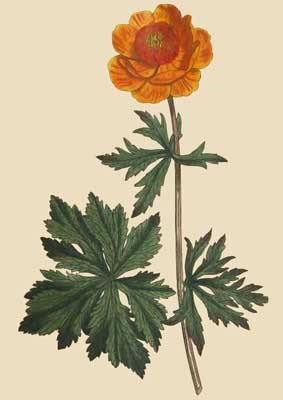
No235.
Of this genus, two species only have as yet been discovered, the one a native of Great-Britain, the other here figured the produce of Siberia and Cappadocia, both hardy, perennial, herbaceous plants; the latter, more particularly, from the bright orange colour of its flowers, held in high estimation as an ornamental plant, and flowering in May and June. This species, as yet rare in this country, is usually propagated by parting its roots in autumn; it may also be raised from seeds, which ripen frequently on strong healthy plants: to succeed in its cultivation, we should plant it in a composition of loam and bog earth, and place it in a north border, taking care that it does not suffer from want of watering in dry summers.
Was cultivated by Mr. Miller, in 1759. Ait. Kew.
[236]
Verbascum Myconi. Borage-Leav'd Mullein
Class and OrderPentandria MonogyniaGeneric CharacterCorolla rotata, subinæqualis. Caps. 1-locularis 2-valvis.
Specific Character and SynonymsVERBASCUM myconi foliis lanatis radicalibus, scapo nudo. Linn. Syst. Vegetab. ed. 14. Murr. p. 220. Ait. Kew. p. 238.
CORTUSA foliis ovatis sessilibus. Linn. Hort. Cliff. 50.
SANICULA alpina, foliis boraginis villosa. Bauh. Pin. 243.
AURICULA ursi myconi. Dalech. Hist. 837.
AURICULA ursi flore cœruleo folio Boraginis. Blew Beares Eares with Borage leaves. Park. Parad. p. 236. 237. f. 3.

No236.
Most of the plants of this genus are tall and shewy; the one here figured is however, of very humble growth, its flowering stem in the cultivated plant rarely exceeding six inches in height; its flowers are proportionably large, of a blueish purple colour, and highly ornamental; they make their appearance in May, and continue successively in blossom for several months, hence it becomes a desirable plant to cultivate, especially for the decorating of rock-work; it is very hardy, requires a north aspect in the summer, and to be carefully watered in dry weather; will grow in almost any soil, and is usually propagated by planting its roots in autumn.
Grows spontaneously on the Pyrenean Alps; in its wild state it is more dwarfish than our figure represents it, its foliage more woolly, and enriched with various tints, which the plant loses on cultivation; such specimens I saw in the possession of Dr. R. Halifax, of Albemarle-Street, who gathered it on its native Alps.
Was cultivated by Mr. Miller, in 1731, Ait. Kew. and most probably long before that period by Parkinson, who lives a figure and accurate description of it in his Parad. terrestris.
[237]
Oxalis Caprina. Goat's-Foot Wood Sorrel
Class and OrderDecandria PentagyniaGeneric CharacterCal. 5-phyllus. Petala Unibus connect. Caps. Anglos discerns, 5-Gina.
Specific Character and SynonymsOXALIS Carina scapis unbeliefs, foliis ternaries glabris, floribus erects. Thunb. Oxalic, n. 11. Linn. Syst. Vegetab. ed. 14. Murr. p. 433.
OXALIS Peas Capra scapo embellisher, foliis ternaries sub bipartite apiece subtus callouses. Linn. Sp. Pl. ed. 3. p. 622.
OXALIS bulbosa pentacle et hexagonal, floribus margins lutes et copiosis. Burm. Afr. 80. t. 29. et t. 28. f. 3.

No237.
The Cape of Good-Hope, that most fertile source of curious and beautiful plants, affords numerous species of Wood Sorrel, and, among others, the present one, which is distinguished for the largeness of its blossoms; they are of a fine yellow colour, and, when expanded by the influence of the sun, make a very conspicuous figure in the green-house; it begins to flower early in April, and continues about two months in bloom, many flowering stems arising from the same root.
This species is of free growth, and increases plentifully by bulbs, which are produced on the crown of the root, as well as on its fibres; these, when the plant decays, should be taken up, and two or three of the largest planted in the middle of a pot filled with a mixture of bog earth and rotten leaves, well incorporated; towards winter, the pots mould be placed in the green-house, or in a frame so secured as perfectly to keep out frost.
Was cultivated by Mr. Miller, in 1757. Ait. Kew.
[238]
Senecio Elegans. Purple Groundsel, or Ragwort
Class and OrderSyngenesia Polygamia SuperfluaGeneric CharacterRecept. nudum. Pappus simplex. Cal. cylindricus, calyculatus. Squamis apice sphacelatis.
Specific Character and SynonymsSENECIO elegans corollis radiants, foliis pontiffs æqualibus pianissimos margin increased recurved. Linn. Syst. Vegetab. ed. 14. Murr. p. 757.
SENECIO elegans corollis radiants, foliis polos-viscid is pontiffs æqualibus pianissimos, Roach inferno angsts, calycibus hurts. Ait. Kew. v. 3. p. 193.
ASTER Africans Annuus senecionis foliis. Comm. Hort. 2. p. 59. t. 30.

No238.
Linnæus has given to this charming annual the name of elegans, on account of the great beauty of its flowers, the florets of the radius being of a most brilliant purple, and those of the disk bright yellow; colours regarded as peculiar to this plant, till the Sen. venustus described in the Hort. Kew. was discovered and introduced here; it is a native of the Cape and other parts of Africa, grows usually to the height of a foot and a half, or two feet; flowers from June to August, grows readily, requiring the same treatment as other annuals of the more tender kind; seedling plants raised in the autumn in pots, and kept in the green-house or under a frame during winter, will, of course, flower much earlier than plants produced in the spring
Within these few years, a variety of this Senecio with perfectly double flowers, equally brilliant as those of the single kind, has been introduced, and is here figured; this, from its superior beauty, is now cultivated, in preference to the single; there is double variety of it also with white flowers which being less shewy is not so much esteemed; both of these are raised, and that readily, from cuttings, which as soon as well rooted may be planted out in the open borders, where they will be highly ornamental during most of the summer; as young plants are most desirable, we should take care to have a constant succession from cuttings regularly put in, and to preserve pots of such in particular, in the green-house during winter, for early blowing the ensuing summer.
The single sort was cultivated here, by Charles Dubois, Esq. in the year 1700. Ait. Kew.
[239]
Amaryllis Atamasco. Atamasco Lily
Class and OrderHexandria MonogyniaGeneric CharacterCor. hexapetaloidea, irregularis. Filamenta fauci tubi inserta, declinata, inæqualia proportione vel directione. Linn. Fil.
Specific Character and SynonymsAMARYLLIS Atamasco spatha bifida acuta, flore pedicellato, corolla campanulata subæquali erecta basi breve tubulosa, staminibus declinatis æqualibus. Linn. Fil. Ait. Kew. p. 416.
AMARYLLIS Atamasco spatha uniflora, corolla æquali, pistillo declinato. Linn. Spec. Pl. ed 3. p. 420.
LILIO-NARCISSUS Indicus pumilus monanthus albus foliis angustissimis Atamasco dictus. Moris. Hist. 11. p. 366. t. 24.
LILIO-NARCISSUS virginiensis. Catesb. Carol. 3. p. 12. t. 12.
LILIO-NARCISSUS liliflorus carolinianus flore albo singulari cum rubedine diluto. Pluk. Alm. 220. t. 43. f. 3.

No239.
The Amaryllis Atamasco is a native of Virginia and Carolina, in which countries it grows very plentifully in the fields and woods, where it makes a beautiful appearance when it is in flower, which is in the spring. The flowers of this sort are produced singly, and at their first appearance have a fine Carnation colour on their outside, but this fades away to a pale or almost white before the flowers decay. This plant is so hardy as to thrive in the open air in England, provided the roots are planted2 in a warm situation and on a dry soil; it may be propagated by offsets from the roots, which they put out pretty plentifully, especially if they are not transplanted oftner than once in three years. Miller's Dict.
It is usual with the Nurserymen about London to keep this plant in the greenhouse, where it flowers about the end of April.
Mr. Charles Hatton cultivated here in 1680, Ait. Kew. on the authority of Morison.
[240]
Pelargonium Tricolor. Three-Coloured Crane's-Bill
Class and OrderMonadelphia HeptandriaGeneric CharacterCal. 5-partitus: lacinia suprema desinente in tubulum capillarem, nectariferum, secus pedunculum decurrentem. Cor. 5-petala, irregularis. Filamenta 10, inæqualia: quorum 3 (raro 5) castrata, Fructus 5-coccus, rostratus: rostra spiralia, introrsum barbata. L'Herit. Geran.
Specific Character and SynonymsPELARGONIUM tricolor petalis duobus superioribus punctis prominulis lucidis ad basin scabris.
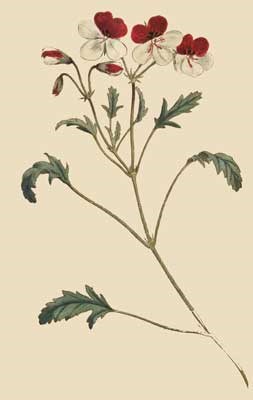
No240.
The Pelargonium tricolor, a species perfectly new, in point of beauty is thought to eclipse all that have hitherto been introduced to this country; its blossoms are certainly the most shewy, in a collection of plants they are the first to attract the eye, the two uppermost petals are of a beautiful red, having their bases nearly black, the three lowermost are white, hence its name of tricolor: this peculiarity of colour joined to their form, has induced some to fancy a similarity betwixt its flowers and those of the Heartsease: to the blossoms of the Lathyrus articulatus in point of colour, they bear also a distant resemblance.
In our eagerness to lay before the public this striking novelty, we may possibly omit some circumstances relative to its history and treatment, which future experience may develope, they will not, however, we trust be very material; the plants which we have had an opportunity of seeing have scarcely exceeded a foot in height, growing up with a shrubby stem, and expanding widely into numerous flowering branches, unusually disposed to produce flowers in a constant succession, so that during most of the summer the plant is loaded with a profusion of bloom; these flowers for the most part go off without being followed by any seed, and when any seed is produced, of which we have seen a few instances, there is generally one perfect and four abortive, frequently all of them fail; the blossoms vary in the number of their stamina, four are most usually apparent, three superior, and that very constantly, one inferior and often two, we have never observed seven, the proper number of fertile stamina in a Pelargonium: the whole plant is covered with short white hairs which give to the foliage a somewhat silvery hue.
Instances have occurred in which one or more of the white petals have had a stripe of red in them, and we have observed that the dark colour at the base of the uppermost petals is, in a certain degree, soluble in water, for on the plants being watered the white petals have here and there become stained by the colouring matter proceeding from it, and which, in a diluted state, is of a purplish tint: as the flowers decay, this apparently black part, distinguished by the roughness of its surface, arising from prominent lucid points, and which essentially distinguish the species, is sometimes perforated with numerous small holes.


